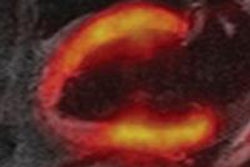
VIENNA - "Hold your horses" was the main message regarding the supercombo PET/MRI at Thursday's ECR 2013 opening press conference. People may want to quickly adopt the fairly new technique, but Dr. Heinz-Peter Schlemmer urged caution.
 Dr. Heinz-Peter Schlemmer of Heidelberg, Germany. Image courtesy of the European Society of Radiology.
Dr. Heinz-Peter Schlemmer of Heidelberg, Germany. Image courtesy of the European Society of Radiology.
"Initial euphoria regarding the medical prospects of PET/MRI for assessing various diseases is understandable as this novel technology matures," said Schlemmer, head of the radiology department at the German Cancer Research Center in Heidelberg, Germany. "But criticism is still justified, because the novel imaging technology cannot enter routine clinical practice before diagnostic accuracy, influence on therapeutic management, and economic factors have been carefully considered and evidenced by clinical studies."
PET and MRI can improve tumor detection by allowing radiologists to see a lesion on both morphological and metabolic images with unrivaled sensitivity and high accuracy, according to Schlemmer.
"Locally, the tumor can be imaged with the best anatomical resolution by MR, and, in addition, you have this metabolic and membrane receptor information about cells from PET, so together you increase your sensitivity and specificity for tumor detection and characterization," he said.
Imaging is probably the most important step in the treatment of the patient, because it determines how the patient is worked up, according to Schlemmer. Therefore it's understandable why radiologists would become so excited about the modality, especially considering PET/MRI improves tumor detection and characterization, aids in therapy monitoring, and works without much ionizing radiation.
The drawbacks for PET/MRI are it's expensive, there is a need for advanced training of staff, it's not easy to operate the system, and there are a lot of technological challenges researchers have to solve.
Money is the driving factor behind PET/MRI's availability, Schlemmer said. "How many patients will have access to the MR scanner, what about the availability, and who's taking the image?" Reimbursement for the radiotracers, the examination, and the data evaluation is unclear. Also, the modality is time-consuming in terms of reporting and communication.
Right now there are only about 30 machines in use and they're mainly at research institutions. When asked about the cost, Dr. Gabriel Krestin, European Society of Radiology president, who also presided at the press conference, jumped in and said, "Ask the vendors." Because PET/MRI is so new and used at research facilities, the current price of the machine will likely change when it is sold more widely, he said.
Many research efforts are still ongoing, but Schlemmer and colleagues said they think this is a technology that's worthy for cancer patients and will improve diagnosis and therapy.
When asked why PET/MRI isn't more prevalent, Schlemmer said, "This is a complex situation; there are two perspectives. One should be, what is the best diagnosis, best treatment for the patient? There are, of course, other forces which are very strong, and that means cost, availability."
There are also questions of whether scanner time is available, and whether the expertise and infrastructure exist.
"It's very easy to be cynical with a very new technology that is not yet established, and that's what we told you. We don't know. That's why we are here, and particularly we as academic radiologists and scientists, that's why we try to prove whether there is any benefit," Krestin added. "It may turn out there is very little added value and maybe it's not cost-efficient, but we don't know. We just don't know."
Radiologists have to prove that PET/MR imaging benefits survival and quality of life, which is happening now in studies, Schlemmer said. The technology is extremely new and challenging. It's a guess that this technology will be great for cancer patients, but it's still a guess, and now researchers have to provide additional experience.



















